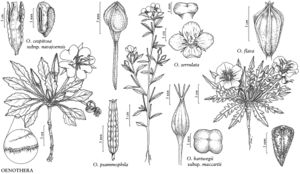Difference between revisions of "Oenothera cespitosa subsp. navajoensis"
Monogr. Syst. Bot. Missouri Bot. Gard. 12: 66, fig. 104. 1985. (as caespitosa)
imported>Volume Importer |
imported>Volume Importer |
||
| Line 54: | Line 54: | ||
|publication year=1985 | |publication year=1985 | ||
|special status= | |special status= | ||
| − | |source xml=https://xjsachs2@bitbucket.org/aafc-mbb/fna-data-curation.git/src/ | + | |source xml=https://xjsachs2@bitbucket.org/aafc-mbb/fna-data-curation.git/src/e39f0e846f172941159b2045254d62d10d9823f6/coarse_grained_fna_xml/V10/V10_17.xml |
|subfamily=Onagraceae subfam. Onagroideae | |subfamily=Onagraceae subfam. Onagroideae | ||
|tribe=Onagraceae tribe Onagreae | |tribe=Onagraceae tribe Onagreae | ||
Latest revision as of 10:31, 9 May 2022
Herbs caulescent or acaulescent, moderately to densely crinkly-villous (often appearing shaggy), and glandular puberulent. Stems (if present) unbranched to few-branched, (0–)10–25 cm. Leaves (3.5–)4–13(–16) × (0.7–)1–3.2 cm; petiole (1.3–)1.7–10(–12) cm; blade oblanceolate to rhombic-obovate, margins often coarsely and irregularly dentate or serrate, sometimes pinnately lobed, often with several larger lobes near blade base. Flowers: buds often recurved when young; floral tube (35–)40–70(–80) mm; sepals 22–27(–32) mm; petals fading pink to light rose, (25–)28–32(–34) mm; filaments 11–15(–17) mm, anthers 9–12 mm; style (50–)59–85(–96) mm. Capsules straight, oblong-lanceoloid, base asymmetrical, 13–35(–40) × 5–6 mm; valve margins with a low sinuate ridge to 8–15 small, nearly distinct tubercles; pedicel 1–3 mm. Seeds narrowly obovoid, 2.1–2.6 × 1.1–1.3 mm, embryo 1/2 of seed volume, surface minutely papillose; seed collar forming a narrow slit above raphe with a slightly sunken membrane, margin entire or obscurely sinuate distally. 2n = 14, 28.
Phenology: Flowering (Apr–)May–Jun.
Habitat: Colorado Plateau region, forming small colonies on loose or compacted soil derived from clay, shale, fine-textured sandstone, or gypsum, on slopes and along small drainage patterns, often around harvester ant mounds, arroyos in somewhat sandy or gravelly soil, in shrubby communities dominated by Atriplex confertifolia, A. corrugata, A. cuneata, Artemisia spinescens, Coleogyne ramosissima, Frankenia jamesii, Hilaria jamesii, with big sagebrush scrub or sage-grasslands, rarely in lower pinyon-juniper woodlands.
Elevation: 1100–1900(–2100) m.
Distribution
Ariz., Colo., N.Mex., Utah.
Discussion
Selected References
None.
